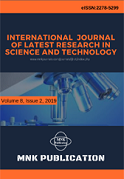DOI:10.29111/ijlrst ISRA Impact Factor:3.35, Peer-reviewed, Open-access Journal
Research Paper Open Access
International Journal of Latest Research in Science and Technology Vol.4 Issue 1, pp 128-133,Year 2015
Correspondence should be addressed to :
Received : 13 February 2015; Accepted : 20 February 2015 ; Published : 28 February 2015

| Download | 125 |
|---|---|
| View | 178 |
| Article No. | 10475 |
Two hybrids (1 and 2) originating from a cross between maize and gamagrass (Tripsacum dactyloides L.) were tested for salinity sensitivity, measured as the reduction in shoot dry weight of plants grown for one month in the range 50-300 mM NaCl, relative to plants grown in the absence of salt. The maternal parental maize line V182 (2n = 4x = 40Zm) and two forage sorghum species were included for comparison. Hybrid 1 (2n = 39; 30Zm + 9Td) and Hybrid 2 (2n = 46; 10Zm+36Td) showed much less biomass reduction at 150 mM and 250mM NaCl, respectively, compared to the moderately salt tolerant parental maize line and more salt sensitive forage sorghum (Sorghum bicolor L. Moench.) and sudangrass (S. sudanese Staph.) cultivars at the same levels. Na+ accumulation in extract of leaves in both hybrids was very low, 7-8-fold lower than in the parental maize and in the growth solutions. It was concluded that the higher salinity tolerance of the two hybrids is attributable to a highly efficient Na+ exclusion mechanism. These results can explain our previous findings that both hybrids produced 11- to 16-fold more forage biomass compared to the parental maize line in a field trial on moderately saline soil.
Copyright © 2015 Yuri Shavrukov and Victor Sokolov et al. This is an open access article distributed under the Creative Commons Attribution 4.0 International (CC BY 4.0) license which permits unrestricted use, distribution, and reproduction in any medium, provided the original work is properly cited.
Yuri Shavrukov and Victor Sokolov , " Maize-gamagrass Interspecific Hybrid, Zea Mays X Tripsacum Dactyloides, Shows Better Salinity Tolerance And Higher Na+ Exclusion Than Maize And Sorghum ", International Journal of Latest Research in Science and Technology . Vol. 4, Issue 1, pp 128-133 , 2015

MNK Publication was founded in 2012 to upholder revolutionary ideas that would advance the research and practice of business and management. Today, we comply with to advance fresh thinking in latest scientific fields where we think we can make a real difference and growth now also including medical and social care, education,management and engineering.

We offers several opportunities for partnership and tie-up with individual, corporate and organizational level. We are working on the open access platform. Editors, authors, readers, librarians and conference organizer can work together. We are giving open opportunities to all. Our team is always willing to work and collaborate to promote open access publication.

Our Journals provide one of the strongest International open access platform for research communities. Our conference proceeding services provide conference organizers a privileged platform for publishing extended conference papers as journal publications. It is deliberated to disseminate scientific research and to establish long term International collaborations and partnerships with academic communities and conference organizers.